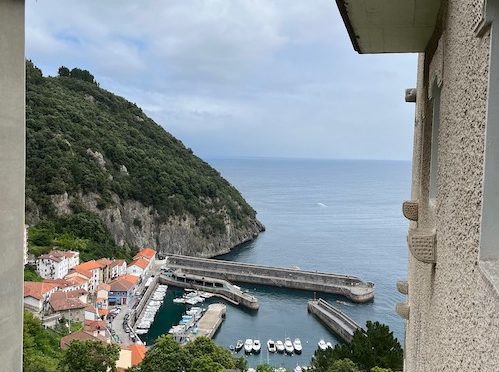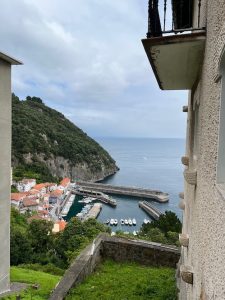Our time in Bizkaia had come to an end and we began our drive to Donostia. However, it is impossible to pass up the opportunity to drive along the coast and visit the small towns that dot the Atlantic. After leaving Bermeo, our first stop was Elantxobe. I’ve been there a few times now, simply fascinated by this marvelous little town that is literally built into the side of a cliff. I just couldn’t resist another visit to show off this curious and unique site. We parked at the top and walked down to the port, where we grabbed a coffee and a pintxo. The walk down was nice and pleasant, weaving through tight sidewalks and narrow stairs. The hike back up, though, was another story…
- Back in 1524, the neighborhood of Elantxobe began to be settled by sailors and fishermen from nearby Ibarrangelua. In fact, the name Elantxobe means the “Elantxo” district, which was a collection of farm houses in Ibarrangelua. In 1783, the port was built to help shelter the fishing boats.
- In the 1600s, Elantxobe served as part of the defense against hostile Dutch and French forces. In 1703, two watchtowers were built on Cape Ogoño to help defend against Oliver Cromwell and English forces. The defenders destroyed the British ships, as well as a group of witches that supposedly lived in the caves of Ogoño.
- Elantxobe remained part of Ibarrangelua until 1858, at which point it became an independent municipality and gained a vote in the General Assembly of Gernika. It was only in 1799 that its own church, dedicated to San Nicolás de Bari, began to be built by the guild of fishermen. The church was blessed in 1803.
- Elantxobe is a small town, with less than 500 people. The population has dropped significantly in the last 100 years, from a peak of about 1900 in the early 1900s, as people left for opportunities in the bigger cities. Nearly all of the inhabitants speak Euskara, specifically a dialect that linguist Louis Lucien Bonaparte classified as that of Bermeo.
- The most distinguishing aspect of Elantxobe is the fact that it is built almost literally into the cliffside. Elantxobe sits in the cliffs of Cape Ogoño, which protects it from the winds of the coast. From the port, it sprawls up the cliff, creating one of the most unique towns along all the Basque coast. The streets are so steep and tight that buses cannot turn around – there is a spinning platform where they park and are turned to leave. The writer and historian Francisco de Arechavala described the houses in Elantxobe in his book Aires del Norte thusly: “Where the roof of the first [house] ends, the second foundation dares to be raised. And so scattered without order or concert, they resembled a herd that was going to the summit.”
- The primary feast day of Elantxobe is June 29 – Saint Peter’s day. However, the town also participates in the fiestas de Madalenas with Bermeo and Mundaka on July 22, welcoming the largest contingent of outsiders during the year.
Primary sources: Castaño García, Manu. ELANTXOBE. Auñamendi Encyclopedia. Available at: https://aunamendi.eusko-ikaskuntza.eus/en/elantxobe/ar-47073/; Elantxobe, Wikipedia
Discover more from Buber's Basque Page
Subscribe to get the latest posts sent to your email.




I cannot tell you how much I enjoy reading your articles. I wait for the next one to show up in my email and read it immediately. I am presenting a seminar for the National Council for Geographic Education in Columbia, SC the last week of October and would like to give the instruction for teachers who would like to learn more about the Basques from reading the Buber Page. Is that possible? Thank you.
Kaixo Byron! Thank you for the great note! I’m glad you enjoy the articles!
I’m not sure what kind of instructions you mean, but I don’t see any issue at all. This is a public-facing site so anyone can see it. I’m very pleased to hear that you will be mentioning this page in your presentation!
Thank you very much for this very interesting journey through our homeland, and for taking your time to explain it and uploading some images.
Please do not forget visiting Ea, between Elantxobe and Lekeitio.
ESKERRIK-ASKO.
We didn’t make it to Ea this time. Hopefully next time. Always too much to see!